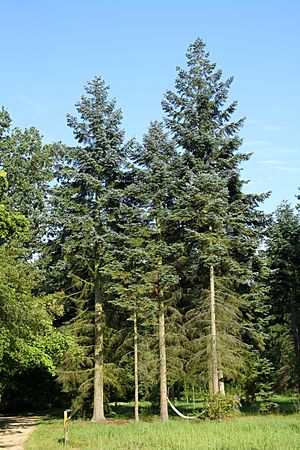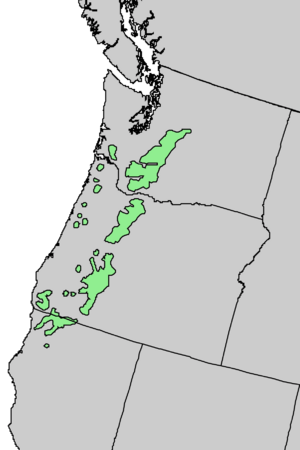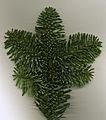Noble fir facts for kids
Quick facts for kids Noble fir |
|
|---|---|
 |
|
| Conservation status | |
| Scientific classification | |
| Genus: |
Abies
|
| Species: |
procera
|
 |
|
| Natural range | |
| Synonyms | |
|
|
The noble fir (scientific name: Abies procera) is a tall and beautiful tree found in western North America. People also call it the red fir or the Christmas tree because it's so popular during the holidays! It grows in the Cascade Range and Coast Range mountains, mainly in northwest California, western Oregon, and Washington in the United States. This tree loves high places, usually growing at altitudes from about 300 to 1,500 meters (1,000 to 5,000 feet) above sea level.
Contents
What the Noble Fir Looks Like
The noble fir is a very large evergreen tree. Evergreen means it keeps its green leaves all year round. These trees can grow up to 70 meters (230 feet) tall, which is like a 20-story building! Their main trunk can be about 2 meters (6.5 feet) wide. Some rare noble firs can even reach 90 meters (295 feet) tall and 2.7 meters (8.9 feet) wide.
Bark and Leaves
Young noble fir trees have smooth, gray bark with little bumps that contain sticky resin. As the tree gets older, its bark turns reddish-brown, becomes rough, and has deep cracks.
The leaves are like needles, about 1 to 3.5 centimeters (0.4 to 1.4 inches) long. They are a pretty blue-green color on both sides. They have special lines called stomatal bands which are tiny pores for the tree to "breathe." The tip of each needle is usually blunt or has a small notch. The needles grow in a spiral pattern around the branch. They twist slightly to curve upwards, covering the branch almost completely.
Cones and Seeds
The cones of the noble fir stand upright on the branches. They are quite large, usually 11 to 22 centimeters (4.3 to 8.7 inches) long. The purple scales of the cone are mostly hidden by long, yellow-green parts called bracts that stick out. When the cones are ripe in the fall, they turn brown and break apart. This releases the seeds, which have small wings to help them fly away in the wind.
The scientific name procera means "tall," which perfectly describes this impressive tree!
Noble Fir vs. Red Fir
The noble fir is very similar to another tree called the red fir (Abies magnifica). The red fir grows further southeast in southern Oregon and California.
You can tell them apart by looking closely at their needles. Noble fir needles have a small groove (like a tiny ditch) along the middle on the top side. Red fir needles do not have this groove. Also, red fir needles are usually less tightly packed on the branch, so you can see the bark of the shoot between them. With noble fir, the needles are so close that they mostly hide the shoot.
Some scientists think that a certain type of red fir, called Abies magnifica var. shastensis, might be a hybrid (a mix) between the noble fir and the red fir.
How People Use Noble Fir
Noble fir trees are very popular for several reasons:
- Christmas Trees: They are one of the most popular choices for Christmas trees because of their beautiful shape, strong branches, and long-lasting needles.
- Wood: The wood from noble fir trees is strong and useful. It is often used for building things like houses or other structures. It is also used to make paper.
- Gardens: There is a special type of noble fir called A. procera (Glauca Group) ‘Glauca Prostrata’. This type grows low to the ground and has pretty gray needles. It has even won an award called the Royal Horticultural Society’s Award of Garden Merit for being an excellent garden plant.
Images for kids
See also
 In Spanish: Abeto noble para niños
In Spanish: Abeto noble para niños





